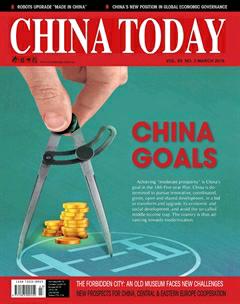Quanzhou— Start of the Maritime Silk Road
By BILL BROWN
Quanzhou— Start of the Maritime Silk Road
By BILL BROWN
IN November 2002, during a din
ner in Fuzhou, then governor of Fujian Province Xi Jinping said to me: “You’ve written a book about Xiamen, your second home. Why don’t you write about Quanzhou, your third home?” I laughed. But I had no idea that within a year, I’d not only write “Mystic Quanzhou” but also be the city’s spokesman at the international Award for Livable Communities Competition held in the Netherlands, and witness its winning of the gold medal.
The key to my third home’s great successes today lie in its uniquely rich history – Chinese have lived in the area almost 2,000 years, and the Tang Dynasty (618-907) designated it as a city in AD 718. By AD 1000, it rivaled Alexandria in Egypt as the greatest port in the world and had developed into a melting pot like today’s New York, but a millennium earlier.

Lao Pan together with a Hui’an maiden.
As the starting point of the ancient Maritime Silk Road, Quanzhou has always been a hub of cultural diversity. Tumen Street perfectly illustrates this blend of religions and ethnicities. Many different religious institutions have stood side by side on the street for hundreds of years. Followers of Islam, Buddhism, Taoism, Christianity, and other religions here practice their faiths while respecting others.

Overseas students in Quanzhou.
The city is home to 60,000 Muslims and has seated seven mosques, including the most beautiful mosque outside of the Middle East, in its history. Designated in 1991 as a UNESCO World Museum of Religions, Quanzhou’s residents have also included Nestorian Christians, Tibetan Buddhists, Jains, Hindus, and Jews. It is site of three Franciscan cathedrals and of the last Manichaean Temple on earth. In 2001, Quanzhou received UNESCO’s Asia Pacific Cultural Heritage Award of Merit. Today, the city has a new mosque, an extensive Muslim cultural heritage center, and a UNESCO-partnered maritime museum that houses one of the world’s best collections of ancient Nestorian Christian, Catholic, Manichean, and Hindu relics. There are also almost 200 modern churches throughout the city.
Quanzhou was moreover home to heroes like Koxinga (Zheng Chenggong), hero of the Ming Dynasty (1368-1644), who in 1662 set sail from Xiamen to kick the Dutch out of Taiwan. The Dutch governor once wrote in his book Neglected Formosa:
“Hitherto this island (Taiwan) had always belonged to China, and the Dutch had doubtless been permitted to live there, seeing that the Chinese did not require it for themselves; but requiring it now, it was only fair that Dutch strangers, who came from far regions, should give way to the masters of the island …He came not with a view to wage … but only to take possession of his belongings.”
Quanzhou people are not only master merchants and brave warriors but also skilled in every art imaginable. When foreigners think of China, they think of tea, silk and porcelain, and Quanzhou was famed for all three. Quanzhou silk rivaled that of Hangzhou, hence the Arab name for it of Zayton, originating in the English word “silk.” Dehua, north of Quanzhou, was one of China’s four great porcelain centers. In Europe, porcelain was as costly as gold and consequently often called “white gold.” While Chinese had produced porcelain since 200 BC, certain 18th century European kings nearly bankrupted their countries in their search for the secret of “white gold.”
And had it not been for Quanzhou’s Anxi tea, there may not have been a United States! It was Anxi tea loaded on to three ships from Xiamen that rioters tossed into the ocean during the infamous Boston Tea Party of 1773. Had there been no Anxi tea to toss, there may have been no Revolutionary War, and today we Americans would still speak British English, drink tea instead of coffee, eat fries with vinegar instead of ketchup, and our judges would wear the silly white wigs that Hong Kong judges wear to this day.
In addition to tea, porcelain and silk, Quanzhou is the home of Southern Chinese Opera (Nanyin), as well as Chinese marionettes, which in the hands of a master come to life, their tiny hands even capable of picking up a piece of paper from the floor.
Quanzhou is so fascinating that I’ve spent weeks traveling to every corner of the city. My favorite spots include the twin Kaiyuan Pagodas, the 1,000-year-old Ashab Mosque (modeled after one in Damascus), Hui’an’s walled city of Chongwu and its stone carvers and uniquely costumed Hui’an maidens, the Stone Forest of Yongchun — second only to Yunnan’s Stone Forest, the ancient ship building communities and fishermen on the coast, ancient stone bridges, which 1,000 years ago were the longest in the world and built through biological engineering (live oysters cemented the stones together!), and Qingshuiyan Temple, which reminds me of a Fujianese version of the Potala Palace. But modern Quanzhou is just as exciting.

Quanzhou is the home of Chinese marionettes.
Quanzhou is the ancestral home of millions of overseas Chinese, many of whom have returned to invest in businesses, infrastructure, schools, and hospitals. When Quanzhou won the Livcome Awards in 2003, it had achieved China’s third highest GDP growth for medium-sized cities. It not only grew but greened, with urban greenery doubling from 16.1 percent to 31.2 percent.
When I first visited Quanzhou in 1989 its streets were narrow and potholed and many buildings derelict beyond repair. Through all the years since the city has built new streets and rebuilt literally miles of buildings in a style that marries modern with traditional Minnan (South Fujian) — stone and red brick, with intricate carvings of the phoenix, dragon and other mythical figures. Quanzhou has many fine museums, but the city itself is one vast, open-air museum wherein people daily enjoy going to and from work and school.
Ancient Quanzhou was famous for its miniature landscapes and their balance of plants and rocks. Today, the city consists of giant miniature landscapes, with a beautiful balance of natural heritage and parks with the modern Minnan architecture that helped the city to win its gold medal.
Twenty-seven years after coming to China, my wife and I still sometimes spend a weekend in Quanzhou, taking evening strolls along the ancient narrow lanes, and enjoying its unique marriage of East and West, Old and New.
I love Xiamen, but in my next life I think I’ll try Quanzhou!
DR. BILL BROWN is a professor at the School of Management’s MBA Center of Xiamen University.

